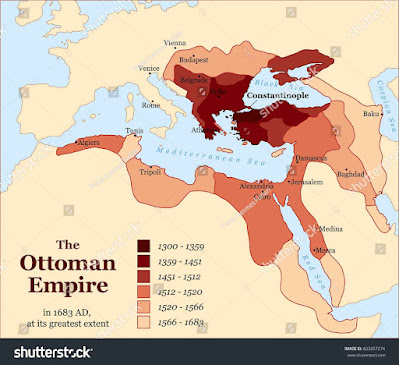Ottoman Empire
The Ottoman Empire was a vast state that spanned three continents and lasted for more than 600 years, from its foundation in 1299 to its dissolution after World War I in 1922. It was founded by Osman Bey, a chieftain from the region of Söğüt in Anatolia, who established a small principality in the region that eventually grew into a powerful empire.
The Ottomans were initially a small tribal confederation of Turkish-speaking people, who gradually expanded their territory through conquests and alliances with other Turkish tribes in Anatolia. The Ottomans quickly became a formidable military power, thanks to their skilled cavalry and the use of gunpowder technology, which they had learned from their encounters with the Mongols.
The Ottomans were known for their policy of tolerance towards religious minorities. They allowed Christians and Jews to practice their faiths, and even allowed them to govern themselves in certain areas. This policy was known as the millet system, and it helped to create a diverse and cosmopolitan society in the Ottoman Empire.
The Ottoman Empire reached the height of its power during the reign of Sultan Suleiman the Magnificent, who ruled from 1520 to 1566. During his reign, the Ottomans conquered Hungary, Iraq, and parts of North Africa, and established diplomatic relations with European powers such as France and England. The Ottoman Empire was ruled by a sultan, who was considered to be the head of both the state and the Islamic faith. The sultan was advised by a council of ministers known as the Divan, and he was assisted in his duties by a large bureaucracy.
The Ottomans were known for their architectural achievements, which included the construction of magnificent mosques, palaces, and other public buildings. One of the most famous Ottoman architects was Sinan, who designed many of the empire's most iconic structures. The Ottomans were also known for their cultural achievements. They developed a distinct style of art known as Ottoman miniature painting, which featured intricate designs and vivid colors. Ottoman literature also flourished during this period, with many notable poets and writers producing works in Turkish and Arabic.
The Ottomans were involved in numerous wars and conflicts throughout their history. They fought against the Safavids in Iran, the Mamluks in Egypt, and the Habsburgs in Europe. The Ottomans also played a significant role in the First World War, siding with Germany and Austria-Hungary.
The decline of the Ottoman Empire began in the 18th century, as the empire faced increasing pressure from European powers. The Ottomans lost territory in Europe and North Africa, and their military and administrative institutions were unable to keep pace with the rapid changes taking place in the world. The Ottomans attempted to reform their government and modernize their military in the 19th century, but these efforts were largely unsuccessful. The empire continued to decline, and by the early 20th century, it had become known as the "sick man of Europe."
The Ottoman Empire played a significant role in the history of the Middle East, and its legacy can still be seen in the region today. The borders of many modern countries, including Turkey, Iraq, and Syria, were established by the Ottomans. The collapse of the Ottoman Empire had a profound impact on the Middle East, leading to the emergence of new states and political movements. The rise of Arab nationalism and the establishment of Israel are just two examples of the long-term effects of the empire's collapse. Despite its decline, the Ottoman Empire remains an important part of Turkish national identity. Many Turks today still look back on the Ottoman period with pride, seeing it as a time of great achievements and cultural richness.




















0 Comments
If you have any doubt please let me know